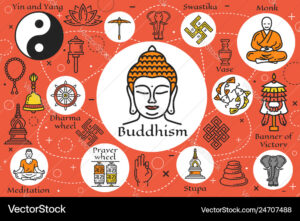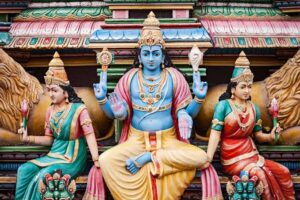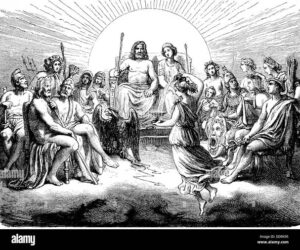ABSTRACT:
The most important discussion that what exactly the Western philosophers before the time of René Descartes Believed exactly the essential constituents of the entity that is called religion; this is the Specific particular, and the most important institution that has substantially influenced human society as well as the significant surroundings of a man in general. It becomes imperative to completely grasp the meaning of this particular term to understand its characteristics and galvanize a series about its nature so that we can assert in a better sense, reflect critically about this particular institution that is essential for humankind and customs.
INTRODUCTION:
If you are to start by the very word that is religion, it is stemming from the root word that is “Relegare” And this roughly means to bind here, we are talking about the act of binding a human being to the almighty- the God Who is omniscient, omnipotent, eternal, infinite, and omnipresent. Now, The divine and endless mind that is God by the virtue of religion. It could be emphatically stated that we are weaving, in a chain which is unbreakable, and that chain is connected to God himself. But if we talk about the additional definition that could be rendered to the idea of religion, it could come from the fact that it is binding a particular human being to another fellow human being. The relationship that has been established between these manifestations is a relationship that is harmonious, cooperative and significant, this is what it truly means to be religious in particular, and what is religion in general terms. Customs here, play pivotal role.
This face of religion is also possessing certain essential characteristics that determine the true nature and the essence of religion within its deep fragments. Those words are not just entities that are spoken in order to enforce rules, but rather it is a systematic pattern of proclamatory commandments that are there intact in place in order to console help as well as nurture the human beings on one hand and the society on the other hand.
MAIN BODY:
Religion must possess certain qualities such as the possession of a specific supernatural entity. There are various religions in the world and there are a plethora of followers of those particular religions. If we try to have a microscopic analysis of the world religion, we will be able to declare it very efficiently. The very fact that each and every religion is possessing a concept pertaining to a divine entity that they either call as God supreme being or by any other name pertaining to the Almighty. Then they are also having faith as well as a subjective commitment towards God, which is unwavering and is placed at a very high pedestal as compared to anything in their lives. People have a very high level of belief, trust, as well as faith in the supreme mind with which they intend to bind themselves.
Then we come across another face, it of religion that is having certain symbols, rituals, and rites; these practices and exercises that stem from the traditional roots of the customary morality are of tremendous importance for any as well as every religion being practiced in this universe, whether that religion is a Cosmopolitan or a tribal one, they have certain religious exercises, certain rituals that are either performed on consecutive days, or there are specific days that are particularly marked for the initiation as well as commencement of certain practices that are placed at a very high pedestal in any religion, the theologians have placed a very essential role here by providing the solutions for the negative inconsistencies that have been adequately highlighted by people who are in opposition to the religion. People from the theological side are of the opinion that these practices in every religion are an integral constituent unit of that particular belief system as well as, they are to be considered acknowledged and regarded with highest esteem possible .
We can also add another characteristic of religion, which is having reverence towards the Deity, in the Indian conceptualization, the reverence is to be interpreted in the sense of a deep Shrādha-Bhāva for Iśvãra, This concept has been evidently highlighted in the vedantic concept promulgated by Rāmanujacãṛya of Sāgūna Brāhṁa– which could be interpreted as the qualified entity who is possessing a specific and a particular form, which is in stark opposition to the formless ultimate reality that has been eloquently reiterated by Sḥankaraċãrya.
CONCLUSION:
“You are crying?” asked Yadava Prakasha. “What’s wrong with you?”
Ramanuja fearlessly yet humbly replied, “Dear Gurudeva, your interpretations of this verse are not only insensitive to God but also wrong.”
Outraged by Ramanuja’s response, Yadava Prakasha challenged, “You arrogant fool; you think you are better than your own spiritual master?”
Ramanuja hung his head low.
The guru roared, “Let me see if you can offer a more cogent description.”
Ramanuja replied, “The verse says that Lord Vishnu’s eyes are kapyasam, and you translated the word literally, where kapi means a monkey and asam means buttocks. But this smacks of your insensitivity, because scriptures offer poetic descriptions of the Lord’s beauty. When you understand this mood, you will see the word differently. Therefore to say that the Lord’s eyes are like kapyasam means they are like the beautiful petals of a lotus.”
Above mentioned is the prasanga from the life of shri Ramanuja which effervescently explains the existence of god and thereby the ultimate fountainhead of religion.
In the words of Herbert who identified five “articles” or “elements” that he proposed were found in every religion, which he called the Common Notions, namely: the beliefs that there is a supreme deity, this deity should be worshiped, the most important part of religious practice is the cultivation of virtue, one should seek repentance for wrong-doing, and one is rewarded or punished in this life and the next.
This forms the fundamental basis for every world religion found in this corporeal world. There could be two definitions for religion, each of it has a different purpose to serve and they are also helping to better grapple with the concept of religion covering larger sections of different societies, such as Jainism, Buddhism, etc.. In the substantive form, we are focusing over the belief concept of the religious content, we are stressing over the religious god, the mental consciousness which stands in affirmative of the motion that one must have belief in the omnipotent: all powerful and all knowledgeable god. And on the other hand, we have the functional aspect which specifically lays a crucial eye towards the functions, mechanisms and the relative effects the religion has over the people and in the society. This holistically concludes the concept of religion.



















